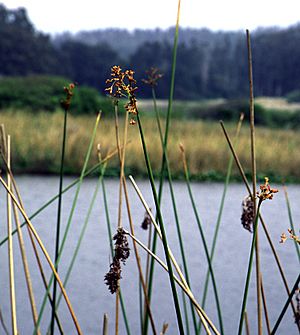Schoenoplectus acutus facts for kids
Quick facts for kids Schoenoplectus acutus |
|
|---|---|
 |
|
| Schoenoplectus acutus var. occidentalis | |
| Scientific classification | |
| Genus: |
Schoenoplectus
|
| Species: |
acutus
|
Schoenoplectus acutus, often called tule or hardstem bulrush, is a very tall plant. It is a type of sedge, which is a plant similar to grass. Tule grows in freshwater marshes across North America. Marshes are wetlands where water covers the ground for long periods.
The name "tule" comes from the Nahuatl word tōllin. This word was used by early settlers from New Spain (now Mexico). They saw these plants in California's Central Valley and thought they looked like plants from around Mexico City.
Tules used to grow all along the shores of Tulare Lake in California. This was once the largest freshwater lake in the western United States. People later drained the lake. The saying "out in the tules" means a remote or isolated place.
Contents
What Tule Looks Like and Where It Grows
Schoenoplectus acutus has a thick, round, green stem. It can grow from 1 to 3 meters (about 3 to 10 feet) tall. It has long, grass-like leaves. Its pale brownish flowers grow in clusters.
Tules are very important for the environment. They grow along shorelines and help protect the land. They act like a buffer against strong winds and water. This helps stop the land from washing away, a process called erosion. Tules also help other plants grow by making the area more stable. Sometimes, people replant tule rhizomes (underground stems) in areas where erosion has happened.
There are two main types, or varieties, of Schoenoplectus acutus:
- Schoenoplectus acutus var. acutus – found in northern and eastern North America.
- Schoenoplectus acutus var. occidentalis – found in southwestern North America.
History and Cultural Uses

Many Native American groups have used tules for a long time. They dye and weave the plants to make many things. These include baskets, mats, hats, and even clothing. They also made duck decoys and boats from tules.
The Salish people once lived in tents. These tents were covered with mats made from sewn tule. Some tribes, like the Wanapum and Pomo people, built houses from tules. They even did this as recently as the 1950s. They still build them for special events today.
The Bay Miwok, Coast Miwok, and Ohlone peoples used tules to make canoes. These canoes, called balsas, helped them travel across the San Francisco Bay. They used them to gather food from the ocean and wetlands. Northern groups of Chumash also made canoes from tules. They used these canoes to collect food from the sea.
The Paiutes, another Native American tribe, called a nearby tribe the Si-Te-Cah. This name means "tule eaters." This is because young tule sprouts and shoots can be eaten raw. The underground stems (rhizomes) and young flower heads can be boiled like vegetables.
A young girl named Ni'ka, or Lucy Moore, was a Pomo survivor of a difficult event in Northern California. She was 6 years old and hid among the tule reeds to stay safe. Her family later started the Lucy Moore Foundation. This group works to improve relations between the Pomo people and other Californians.
Tule in Place Names and Wildlife
Tule is very common in California's wetlands. Because of this, many places in the state are named after it.
- Tulare County is named after a "tulare," which is a tule marsh.
- Tule Lake is near the Oregon border. It includes the Tule Lake National Wildlife Refuge. This lake was also the site of an internment camp during World War II. At its busiest, about 18,700 Japanese Americans were held there.
- The town of Tulelake is northeast of the lake.
- California also has a Tule River.
- The Tule Desert is in Arizona and Nevada. Nevada also has a place called Tule Springs.
The thick, low-lying tule fog in California is named after the plant. So are the tule elk and tule perch. The giant garter snake (Thamnophis gigas) also lived closely with tule marshes in California's Central Valley.
Other Uses of Tule
People can make flour from the older tule roots. First, they peel and cut the roots. Then, they crush and boil them. After removing any tough fibers, they dry the mixture. The seeds can also be ground up and mixed with the root flour.
See also
 In Spanish: Tule para niños
In Spanish: Tule para niños

